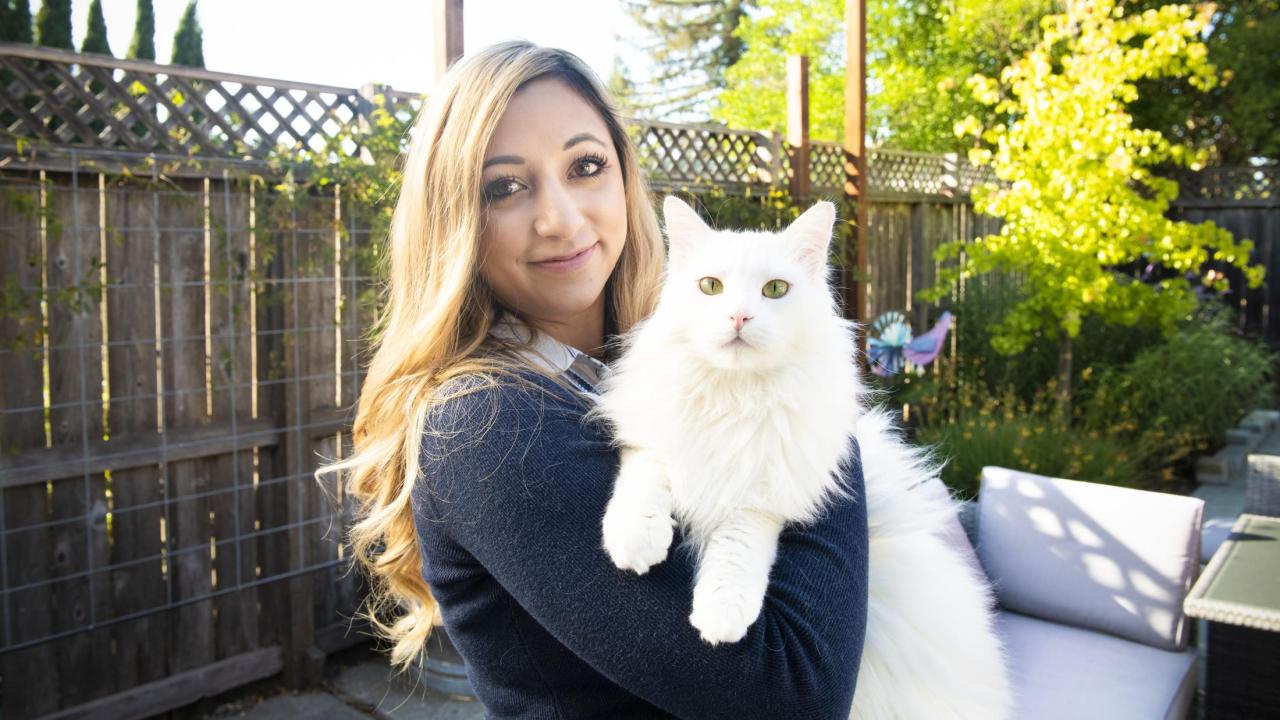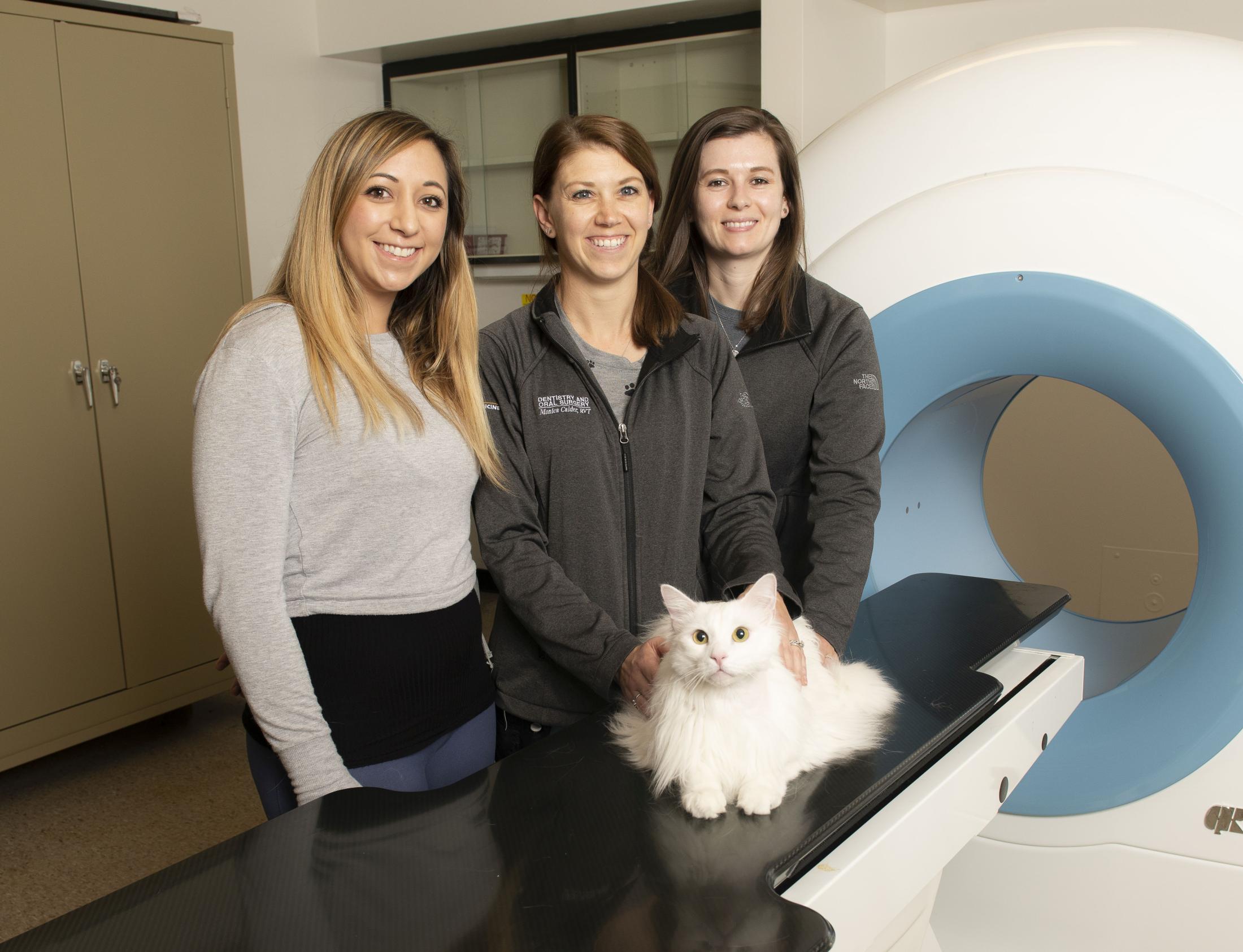
Dedicated Care Team Leads Way to Success
Kevin, a 3-year-old male domestic longhair cat, required a CT scan to determine the extent of his maxillofacial injuries. Like with all cases in the Dentistry and Oral Surgery Service (DOSS) that need this imaging, Kevin was wheeled to the cone-beam CT machine by registered veterinary technicians (RVTs) Monica Calder and Megan Loscar. While this sounds like an easy enough task, it’s actually quite labor intensive due to the vastness of the UC Davis veterinary hospital.
In order for animals to receive CT scans, they need to be anesthetized. To get Kevin from the Anesthesia/Surgery Prep room to the cone beam CT, Calder and Loscar—one pushing a cart Kevin is on; the other pulling the connected anesthesia cart—have to take him nearly 250 yards from one building to another, across an exterior covered walkway, down an elevator, and through several crowded hallways. The process, while safe, is far from ideal. If the animal needs to immediately go into surgery following the CT scan, like Kevin did, the traveling process has to then be reversed back to the operating rooms, which are located near the original starting point.

Kevin’s injury was caused by an attack from a neighbor dog that left him with a broken jaw. After owner Natalia Caceres took him to a local emergency room, Kevin was referred to the DOSS specialists for a complex surgery to repair his fractured mandible. Dr. Boaz Arzi, assisted by residents Drs. Mercedes De Paolo and Armeti Aghashani, used a titanium plate and screws to stabilize Kevin’s jaw. The surgeons also had to extract a fractured tooth, close the open wounds in Kevin’s mouth, and place a wire around the intermandibular joint.
The CT process was then repeated to obtain postoperative images that showed positive results and an excellent prognosis. In all, Calder and Loscar wheeled Kevin more than a half mile through the hospital – a task performed by them approximately 150 times a year. The hospital places great value in dedicated staff members like the two DOSS technicians, and acknowledges that efforts like theirs empower its success.
Growing up, both had aspirations of making a career out of working with animals. Calder saw tech school and an RVT certification as a way of achieving that goal. Loscar grew up volunteering with animals at fairs and other 4-H and Future Farmers of America activities, as well as animal adoption events.
“I always wanted to work in veterinary medicine,” said Loscar. “My decision to become an RVT really came when I was volunteering at a veterinary hospital. I recognized the connection the RVTs had with their patients and their ability to advocate for them both to their doctors and to their owners.”
Both Calder and Loscar stated that their favorite aspect of being RVTs at the UC Davis veterinary hospital is working with the many police K9 officers that DOSS treats. Annually, the service provides free oral examinations for the working dogs.
“I enjoy being able to help with something that betters the community,” said Calder. “It’s a way for us to give back, even if it’s just a little bit.”
As K9s rely on their mouths for much of their work, oral health is paramount to them performing at an optimal level.
“I really enjoy working with the K9s, as they dedicate their lives and service to our communities,” Loscar said. “It’s nice to be able to provide them with quality dental care to keep them healthy and on the job for as long as possible.”
UC Davis is currently in the initial stages of construction on a new Veterinary Medical Center (VMC) that will ultimately create one of the foremost, state-of-the-art veterinary hospitals in the world. To alleviate issues such as imaging equipment being located far from operating rooms, the VMC is being built with strategic positioning in mind. Phase I of the project includes an All Species Imaging Center—pivotal to all clinical specialties—that will be centrally located to serve all patients, large and small. The strategic placement of imaging technology and expertise will expedite diagnosis and patient care, reduce stress and wait time for our patients and optimize operational efficiencies.
The All Species Imaging Center, staffed by the largest veterinary diagnostic team in the world, will be at the cutting edge of detecting, diagnosing and treating disease and trauma. By utilizing information learned through research, radiologists and clinicians will continue to advance the care and rehabilitation of all animals. The center’s imaging modalities will include radiography (x-ray), computed tomography (CT scan), nuclear scintigraphy, ultrasound, magnetic resonance imaging (MRI), and positron emission tomography (PET scan).
“I enjoy the cutting-edge medicine that occurs here at UC Davis,” said Loscar. “I feel this environment pushes all of us to do better and strive to provide the best care for our patients.”
Successful outcomes are a direct result of Calder’s and Loscar’s dedication to their patients.
Several months after the surgery, Kevin has completely recovered from his injuries.
“It’s like nothing ever happened to him,” said Caceres, who reports that Kevin is eating pain free and is back to his old self. “We are so happy with how everything turned out. It couldn’t have been better.”
# # #
